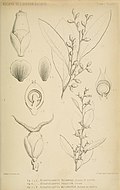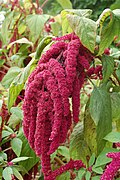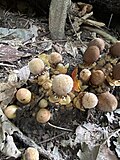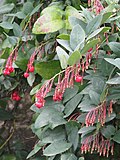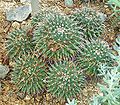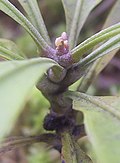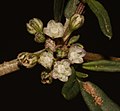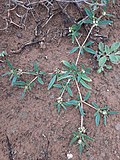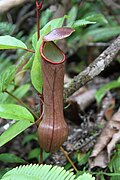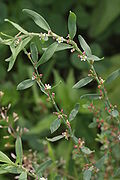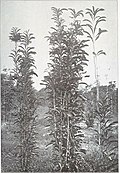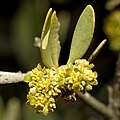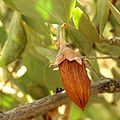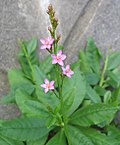List of basal superasterid families
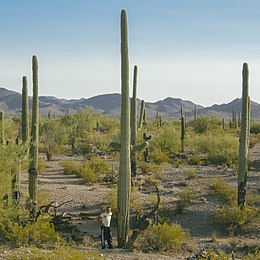
| Flowering plant families (APG IV) | |||||
|---|---|---|---|---|---|
|
|
|||||
| Early-diverging flowering plants | |||||
| Monocots: Alismatids • Commelinids • Lilioids | |||||
|
|
|||||
Eudicots
|
The basal superasterids are three orders of flowering plants – Caryophyllales, Santalales and Berberidopsidales – that belong to the superasterids.[a] They include 47 families of woody and non-woody plants, cactuses and other succulents, and plants that grow in soil, in water and on other plants.[4]
The spinach family includes sugar beets, which account for a fifth of the world's sugar consumption. Opuntia ficus-indica, a prickly pear species, is the most common food crop of the cactuses. Carnations are cultivated for their oils and for the cut-flower trade. Sundews, Venus flytraps and the aquatic Aldrovanda all have leaves that surround, trap and digest insects and other small animals. Nepenthes catches its prey with slippery pitchers of water and digestive juices. The garden ornamental Lewisia can survive two-year droughts. Jojoba oil, widely used in cosmetics and pharmaceuticals, is similar to the oils produced by human skin glands.[5]
Glossary
[edit]From the glossary of botanical terms:
- annual: a plant species that completes its life cycle within a single year or growing season
- basal: attached close to the base (of a plant or an evolutionary tree diagram)
- climber: a vine that leans on, twines around or clings to other plants for vertical support
- herbaceous: not woody; usually green and soft in texture
- perennial: not an annual or biennial
- scale: a reduced leaf or a flattened outgrowth
- succulent (adjective): juicy or fleshy
- unisexual: of one sex; bearing only male or only female reproductive organs
- woody: hard and lignified; not herbaceous[6]
The APG IV system is the fourth in a series of plant taxonomies from the Angiosperm Phylogeny Group.[2] In this system, the superasterids (named for the asters) account for more than a third of all flowering plant species.[7][8][9] Caryophyllales, Santalales and Berberidopsidales are basal within the superasterids. Caryophyllales species characteristically have perisperm (a source of nutrition for the embryo), campylotropous (rotated) ovules, and roots that lack symbiotic fungal relationships.[10][11] The small order Berberidopsidales (just four species) may be the earliest-diverging superasterid order. In Santalales, an order of parasitic plants, the relationships between the families are not completely understood.[12]
Families
[edit]| Family and a common name[13][b] | Type genus and etymology[c] | Total genera; global distribution | Description and uses | Order[13] | Type genus images |
|---|---|---|---|---|---|
| Achatocarpaceae (snake-eyes family) | Achatocarpus, from Greek for "agate fruit"[15][16] | 2 genera, from southern North America to Argentina[17][18] | Small trees and shrubs, many with unisexual flowers and pointed branchlets and some with thorns[15][19][20] | Caryophyllales[15] | Three Achatocarpus species |
| Aextoxicaceae (olivillo family) | Aextoxicon, from Greek for "goat poison"[21] | 1 genus, in Chile and Argentina[21][22] | Unisexual trees with scaly rust-tinted flowers, leaves and branches[21] | Berberidopsidales[21] | |
| Aizoaceae (dewplant family) | Aizoon, from Greek for "always living" or "hardy"[23][24] | 120 genera, in the drier tropics and subtropics[25][26] | Shrubs and herbaceous succulents. New Zealand spinach and Sesuvium portulacastrum are cultivated as leaf vegetables. Living stones and some species with leaf windows are popular ornamentals.[23][27][28] | Caryophyllales[23] | |
| Amaranthaceae (spinach family) | Amaranthus, from Greek for "unfading"[29][30][31] | 183 genera, mostly tropical, with some warm temperate species[32][33] | Shrubs and herbaceous plants, with a few vines and trees. The family includes spinach, quinoa, sugar beets and other foods, along with many common garden ornamentals, such as Amaranthus and Gomphrena.[19][34][35] | Caryophyllales[34] | |
| Anacampserotaceae (love-plant family) | Anacampseros, from a Greek plant name[36][37] | 3 genera, scattered in the Americas, Africa, Yemen and Australia[38][39] | Succulent herbaceous perennials, some woody at the base[38] | Caryophyllales[38] | |
| Ancistrocladaceae (kardal family) | Ancistrocladus, from Greek for "fish-hooked branches"[40] | 1 genus, in tropical Africa and Asia[40][41] | Woody vines and climbing shrubs. The genus's antimicrobial properties are under investigation.[40][42] | Caryophyllales[40] | |
| Asteropeiaceae (manoko family) | Asteropeia, for Asteropeia, daughter of the mythological king Pelias[43] | 1 genus, in Madagascar[44][45] | Shrubs and trees[44] | Caryophyllales[44] | |
| Balanophoraceae (snake-mushroom family) | Balanophora, from Greek for "acorn-bearing" (for the shape of the male flower heads)[46][47] | 16 genera, scattered in the tropics, East Asia, South Africa and New Zealand[46][48] | Herbaceous succulents without chlorophyll that are parasitic on roots and rhizomes[42][46] | Santalales[46] | |
| Barbeuiaceae (liane-barbeu family) | Barbeuia, for Jacques Barbeu-Dubourg (1709–1779)[49] | 1 genus, in Madagascar[49][50] | Woody vines with leaves arranged in spirals[49] | Caryophyllales[49] | |
| Basellaceae (Malabar-spinach family) | Basella, from a Malabar plant name[51][52] | 4 genera, mostly in the Andes and the tropics of the Americas[53][54] | Succulent herbaceous perennials and vines, frequently with thick roots or tubers. Ulluco tubers were an important food crop in pre-Columbian Ecuador and Peru, and still are. Malabar spinach is a popular subtropical and tropical vegetable.[55][56][57] | Caryophyllales[56] | |
| Berberidopsidaceae (coral-vine family) | Berberidopsis, from Greek for "like Berberis"[58][59][60] | 2 genera, in eastern Australia and southern Chile[61][62] | Three species of woody vines, all with leaves that grow in a spiral pattern[61] | Berberidopsidales[61] | |
| Cactaceae (cactus family) | Mammillaria. Cactus, an earlier synonym, is from a Greek plant name.[63][64][65] | 150 genera, almost entirely in the Americas[66][67] | Perennial evergreen shrubs, trees and vines, usually leafless with fat green succulent stems. Many species are houseplants or arid-climate ornamentals.[55][63][68] | Caryophyllales[63] | |
| Caryophyllaceae (carnation family) | Dianthus. Caryophyllus, an earlier synonym, is from Greek for "nut (scented) leaves".[69][70][71] | 101 genera, mostly in the Northern Hemisphere[72][73] | Mostly herbaceous plants, with some shrubs and small trees, rarely unisexual. Many genera, including Gypsophila (baby's breath), are grown as ornamentals. Carnations have been grown for at least two thousand years.[27][69][74] | Caryophyllales[69] | |
| Didiereaceae (octopus-tree family) | Didierea, for Alfred Grandidier (1836–1921)[75][76] | 6 genera, all in Madagascar[77][78] | Arid-climate shrubs and trees, sometimes vines. Some species are ornamentals.[79][80] | Caryophyllales[79] | |
| Dioncophyllaceae (hookleaf-vine family) | Dioncophyllum, from Greek for "two-hooked leaves"[81][82] | 3 genera, in West Africa and the Congo Basin[81][83] | Woody vines and climbing shrubs. Triphyophyllum peltatum, which sometimes traps and digests insects, produces useful antimalarial compounds.[42][81] | Caryophyllales[81] | Triphyophyllum peltatum (type genus not shown) |
| Droseraceae (sundew family) | Drosera, from Greek for "dewy" (secretions)[84][85] | 3 genera, widespread, generally in areas with poor soil[86][87] | Herbaceous plants. The popularity of the Venus flytrap, with jaw-like leaves that pin its prey, is endangering the species in the wild.[19][86] | Caryophyllales[86] | |
| Drosophyllaceae (dew-pine family) | Drosophyllum, from Greek for "dewy leaves"[88] | 1 genus, in southwestern Iberia and northern Morocco[88][89] | Herbaceous plants with woody roots. Sticky leaf glands trap and digest insects and other small animals.[88] | Caryophyllales[88] | |
| Frankeniaceae (sea-heath family) | Frankenia, for Johann Francke (1590–1661), a Swedish botanist[90] | 1 genus, widespread in drier, warmer zones[90][91] | Salt-tolerant shrubs and herbaceous plants[42][90] | Caryophyllales[90] | |
| Gisekiaceae (stork's-henna family) | Gisekia, for Paul Dietrich Giseke (1741–1796)[92] | 1 genus, in Africa and southern Asia[93][94] | Herbaceous plants, usually ground-hugging, with many-branched stems[93][95] | Caryophyllales[93] | |
| Halophytaceae (verdolaga family) | Halophytum, from Greek for "salt plant"[96] | 1 genus, in Argentina[97][98] | Succulent herbaceous annuals[96][97] | Caryophyllales[96] | |
| Kewaceae (suring family) | Kewa, for Kew, London, England (site of Kew Gardens)[99] | 1 genus, in eastern and southern Africa[99][100] | Herbaceous plants, some with wood at the base[99] | Caryophyllales[99] | |
| Limeaceae (lizard-foot family) | Limeum, from Latin for "path" (where some grow)[101] | 1 genus, in Africa, Arabia and India[101][102] | Herbaceous plants with stems that grow along the soil surface, often with a woody base[101] | Caryophyllales[101] | |
| Lophiocarpaceae (sandaarbossie family) | Lophiocarpus, from Greek for "small-crested fruit"[103][104] | 2 genera, in Africa, southern Arabia and western India[103][105] | Herbaceous plants, some with wood at the base[103] | Caryophyllales[103] | Corbichonia decumbens (type genus not shown) |
| Loranthaceae (showy-mistletoe family) | Loranthus, from Latin for "strap" and Greek for "flowers"[106][107] | 78 genera, widespread[106][108] | Parasitic evergreen vines, trees and shrubs[42][106] | Santalales[106] | |
| Macarthuriaceae (Macarthuria family) | Macarthuria, for William Macarthur (1800–1882)[109] | 1 genus, in Australia[110][111] | Stiff, rush-like herbaceous perennials with green (photosynthetic) stems[110] | Caryophyllales[110] | |
| Microteaceae (jumby-pepper family) | Microtea, from Greek for "small size", probably[112] | 1 genus, in the tropics of the Americas[112][113] | Herbaceous annuals, sometimes woody at the base[112] | Caryophyllales[112] | |
| Misodendraceae (feathery-mistletoe family) | Misodendrum, from Greek for "hating trees"[114] | 1 genus, in Argentina and Chile[114][115] | Parasitic evergreen unisexual shrubs[114] | Santalales[114] | |
| Molluginaceae (carpetweed family) | Mollugo, from Greek for "soft"[116][117] | 11 genera, mostly in the subtropics and tropics[118][119] | Herbaceous plants (many with wood at the base) and cushion plants or subshrubs. Some Glinus and Mollugo species are used for seasoning.[19][116][120] | Caryophyllales[116] | |
| Montiaceae (blinks family) | Montia, for Giuseppe Monti (1682–1760)[121][122] | 16 genera, mostly in the Northern Hemisphere[121][123] | Mostly herbaceous plants, frequently with swollen roots. One species, bitterroot, was a staple food for some Native Americans.[121] | Caryophyllales[121] | |
| Nepenthaceae (Asian-pitcherplant family) | Nepenthes, from Greek for "antidepressant"[124] | 1 genus, mostly in tropical Southeast and East Asia[125][126] | Unisexual shrubs and vines, some growing on other plants. The tips of some leaves develop into pitchers that trap and digest insects and other small animals. Many species and hybrids are popular ornamentals.[125] | Caryophyllales[125] | |
| Nyctaginaceae (four-o'clocks family) | Mirabilis. Nyctago, an earlier synonym, is from Greek for "night" (flowering).[127][128][129] | 32 genera, mostly in the subtropics and tropics of the Americas[130][131] | Trees, shrubs, herbaceous plants and spine-covered vines. Stem nodes are frequently swollen, and some have spines. Mirabilis expansa has been a food crop since prehistoric times. Mirabilis and Bougainvillea have ornamental species.[55][127][132] | Caryophyllales[127] | |
| Olacaceae (tallow-wood family) | Olax, from Latin for "scented" (wood)[133][134] | 28 genera, in the tropics, and in the subtropics of the Americas[133][135] | Mostly evergreen trees, shrubs and vines, some with scented wood[27][133] | Santalales[133] | |
| Opiliaceae (bally-coma family) | Opilia (derivation unknown)[136][137] | 11 genera, in the tropics and temperate Oceania[136][138] | Parasitic evergreen shrubs and trees, and a few woody vines[42][136] | Santalales[136] | |
| Petiveriaceae (henwood family) | Petiveria, for James Petiver (c. 1660 – 1718)[139][140] | 9 genera, almost entirely in the tropics of the Americas[139][141] | Shrubs, trees, vines and herbs, some with spines[139] | Caryophyllales[139] | |
| Physenaceae (balloonfruit family) | Physena, from Greek for "inflated" (fruit)[142] | 1 genus, in eastern Madagascar[143][144] | Trees and shrubs[143] | Caryophyllales[143] | —
|
| Phytolaccaceae (pokeweed family) | Phytolacca, from Greek for "plant" and modern Latin for "lac", a red dye[145][146][147] | 5 genera, mostly in the tropics and subtropics, with a wider range for Phytolacca[148][149] | Trees, shrubs, woody and semi-woody vines and herbaceous perennials. Indian pokeweed is a leaf vegetable in Asia.[55][150][151] | Caryophyllales[150] | |
| Plumbaginaceae (thrift family) | Plumbago, from a Latin plant name[152][153][154] | 22 genera, worldwide[155][156] | Shrubs, vines and herbaceous perennials. Armeria, Ceratostigma, Limonium and Plumbago are cultivated as ornamentals.[19][157][158] | Caryophyllales[157] | |
| Polygonaceae (knotweed family) | Polygonum, from a Greek plant name[159][160] | 56 genera, worldwide[161][162] | Shrubs, trees, vines and herbaceous plants, some with hollow stems. Buckwheat (not closely related to wheat) is an ingredient in some pancakes and noodles. Leaf stalks of rhubarb are used to make jams and desserts. Edible tubers of coral vine are cultivated in Mexico.[19][163][164] | Caryophyllales[163] | |
| Portulacaceae (purslane family) | Portulaca, from a Latin plant name[165] | 1 genus, mostly in warmer climates[166][167] | Herbaceous succulents, frequently producing tubers. Purslane (from several Portulaca species) is a popular spongey-textured vegetable in many countries.[27][168][169] | Caryophyllales[168] | |
| Rhabdodendraceae (clubfruit-tree family) | Rhabdodendron, from Greek for "rod tree"[170] | 1 genus, in northeastern South America[170][171] | Shrubs and small trees[19][170] | Caryophyllales[170] | |
| Santalaceae (sandalwood family) | Santalum, from a Greek plant name[172][173] | 43 genera, widespread[174][175] | Parasitic plants, including shrubs, trees and vines[27][174] | Santalales[174] | |
| Sarcobataceae (greasewood family) | Sarcobatus, from Greek for "fleshy thorn bush"[176] | 1 genus, in western North America[176][177] | Shrubs with succulent leaves, woody stems, and many thorns[176] | Caryophyllales[176] | |
| Schoepfiaceae (whitewood family) | Schoepfia, for Johann David Schoepff (1752–1800)[178][179] | 3 genera, in South America, tropical North America, and East Asia[180][181] | Parasitic green shrubs, trees and herbaceous perennials[180] | Santalales[180] | |
| Simmondsiaceae (jojoba family) | Simmondsia, for Thomas William Simmonds (1767–1804), an English doctor and naturalist[182] | 1 genus, in southwestern North America[183][184] | Just one species of unisexual evergreen shrubs. Jojoba oil is widely used in cosmetics and pharmaceuticals.[183] | Caryophyllales[183] | |
| Stegnospermataceae (Cuban-tangle family) | Stegnosperma, from Greek for "dry seeds"[185] | 1 genus, from Mexico to Nicaragua and in the Caribbean[186][187] | Small trees and shrubs[19][185][188] | Caryophyllales[185] | |
| Talinaceae (fameflower family) | Talinum, from Greek for "blooming lavishly", possibly[189][190][191] | 2 genera, in the tropics and subtropics of the Americas and Africa[189][192] | More or less herbaceous plants, frequently with root tubers. Some Talinum species are grown as vegetables, and fameflower is an ornamental.[189] | Caryophyllales[189] | |
| Tamaricaceae (salt-cedar family) | Tamarix, from a Latin plant name[193][194][195] | 4 genera, in dry and arid zones, scattered worldwide (since its introduction to the Americas)[196][197] | Trees and shrubs with photosynthetic branchlets. The salt-tolerant Tamarix is used to control erosion of beaches and very dry soil.[27][196] | Caryophyllales[196] |
See also
[edit]Notes
[edit]- ^ The taxonomy (classification) in this list follows Plants of the World (2017)[1] and the fourth Angiosperm Phylogeny Group system.[2] Total counts of genera for each family come from Plants of the World Online (POWO).[3] (See the POWO license.) Extinct taxa are not included.
- ^ Each family's formal name ends in the Latin suffix -aceae and is derived from the name of a genus that is or once was part of the family.[14]
- ^ Some plants were named for naturalists (unless otherwise noted).
Citations
[edit]
- ^ Christenhusz, Fay & Chase 2017.
- ^ a b Angiosperm Phylogeny Group 2016.
- ^ POWO.
- ^ Christenhusz, Fay & Chase 2017, pp. 10, 431–470.
- ^ Christenhusz, Fay & Chase 2017, pp. 437–439, 443, 448–452, 464, 470.
- ^ Christenhusz, Fay & Chase 2017, pp. 638–670.
- ^ Christenhusz, Fay & Chase 2017, p. 10.
- ^ Bremer, Friis & Bremer 2004, p. 496.
- ^ Stevens 2023, Caryophyllales, Santalales.
- ^ Bittrich 1993, p. 13.
- ^ Stevens 2023, Caryophyllales.
- ^ Christenhusz, Fay & Chase 2017, pp. 10, 420–421.
- ^ a b Christenhusz, Fay & Chase 2017, pp. 420–470.
- ^ ICN, art. 18.
- ^ a b c Christenhusz, Fay & Chase 2017, pp. 448–449.
- ^ IPNI, Achatocarpaceae, Type.
- ^ Bittrich 1993, p. 36.
- ^ POWO, Achatocarpaceae.
- ^ a b c d e f g h POWO, Neotropikey.
- ^ Bittrich 1993, p. 35.
- ^ a b c d Christenhusz, Fay & Chase 2017, p. 420.
- ^ POWO, Aextoxicaceae.
- ^ a b c Christenhusz, Fay & Chase 2017, pp. 457–458.
- ^ USDA, Aizoaceae, Type.
- ^ Hartmann 1993, p. 43.
- ^ POWO, Aizoaceae.
- ^ a b c d e f POWO, Flora of Tropical East Africa.
- ^ Hartmann 1993, p. 37.
- ^ Stearn 2002, p. 40.
- ^ Coombes 2012, p. 41.
- ^ IPNI, Amaranthaceae, Type.
- ^ Townsend 1993, p. 75.
- ^ POWO, Amaranthaceae.
- ^ a b Christenhusz, Fay & Chase 2017, pp. 449–452.
- ^ Townsend 1993, p. 70.
- ^ Stearn 2002, p. 42.
- ^ USDA, Anacampserotaceae, Type.
- ^ a b c Christenhusz, Fay & Chase 2017, p. 468.
- ^ POWO, Anacampserotaceae.
- ^ a b c d Christenhusz, Fay & Chase 2017, pp. 441–442.
- ^ POWO, Ancistrocladaceae.
- ^ a b c d e f POWO, Flora of West Tropical Africa.
- ^ Burkhardt 2018, p. A-42.
- ^ a b c Christenhusz, Fay & Chase 2017, pp. 444–445.
- ^ POWO, Asteropeiaceae.
- ^ a b c d Christenhusz, Fay & Chase 2017, pp. 424–425.
- ^ IPNI, Balanophoraceae, Type.
- ^ POWO, Balanophoraceae.
- ^ a b c d Christenhusz, Fay & Chase 2017, p. 455.
- ^ POWO, Barbeuiaceae.
- ^ Stearn 2002, p. 61.
- ^ IPNI, Basellaceae, Type.
- ^ Sperling & Bittrich 1993, p. 145.
- ^ POWO, Basellaceae.
- ^ a b c d POWO, Flora of Zambesiaca.
- ^ a b Christenhusz, Fay & Chase 2017, pp. 465–466.
- ^ Sperling & Bittrich 1993, p. 143.
- ^ Stearn 2002, p. 63.
- ^ Coombes 2012, p. 64.
- ^ USDA, Berberidopsidaceae, Type.
- ^ a b c Christenhusz, Fay & Chase 2017, pp. 420–421.
- ^ POWO, Berberidopsidaceae.
- ^ a b c Christenhusz, Fay & Chase 2017, pp. 468–470.
- ^ POWO, Cactus.
- ^ IPNI, Cactaceae, Type.
- ^ Barthlott & Hunt 1993, p. 168.
- ^ POWO, Cactaceae.
- ^ Barthlott & Hunt 1993, p. 161.
- ^ a b c Christenhusz, Fay & Chase 2017, pp. 446–448.
- ^ POWO, Caryophyllus.
- ^ IPNI, Caryophyllaceae, Type.
- ^ Bittrich 1993, p. 216.
- ^ POWO, Caryophyllaceae.
- ^ Bittrich 1993, p. 206.
- ^ Bayton 2020, p. 111.
- ^ IPNI, Didiereaceae, Type.
- ^ Kubitzki 1993, p. 294.
- ^ POWO, Didiereaceae.
- ^ a b Christenhusz, Fay & Chase 2017, pp. 464–465.
- ^ Kubitzki 1993, p. 292.
- ^ a b c d Christenhusz, Fay & Chase 2017, pp. 440–441.
- ^ IPNI, Dioncophyllaceae, Type.
- ^ POWO, Dioncophyllaceae.
- ^ Stearn 2002, p. 125.
- ^ IPNI, Droseraceae, Type.
- ^ a b c Christenhusz, Fay & Chase 2017, pp. 436–438.
- ^ POWO, Droseraceae.
- ^ a b c d Christenhusz, Fay & Chase 2017, p. 440.
- ^ POWO, Drosophyllaceae.
- ^ a b c d Christenhusz, Fay & Chase 2017, p. 431.
- ^ POWO, Frankeniaceae.
- ^ Burkhardt 2018, p. G-25.
- ^ a b c Christenhusz, Fay & Chase 2017, p. 456.
- ^ POWO, Gisekiaceae.
- ^ POWO, Flora of Somalia.
- ^ a b c Christenhusz, Fay & Chase 2017, p. 466.
- ^ a b Bittrich 1993, p. 320.
- ^ POWO, Halophytaceae.
- ^ a b c d Christenhusz, Fay & Chase 2017, pp. 454–455.
- ^ POWO, Kewaceae.
- ^ a b c d Christenhusz, Fay & Chase 2017, p. 453.
- ^ POWO, Limeaceae.
- ^ a b c d Christenhusz, Fay & Chase 2017, p. 454.
- ^ USDA, Lophiocarpaceae, Type.
- ^ POWO, Lophiocarpaceae.
- ^ a b c d Christenhusz, Fay & Chase 2017, pp. 429–430.
- ^ IPNI, Loranthaceae, Type.
- ^ POWO, Loranthaceae.
- ^ Quattrocchi 2019, p. 1574.
- ^ a b c Christenhusz, Fay & Chase 2017, p. 445.
- ^ POWO, Macarthuriaceae.
- ^ a b c d Christenhusz, Fay & Chase 2017, p. 446.
- ^ POWO, Microteaceae.
- ^ a b c d Christenhusz, Fay & Chase 2017, pp. 427–428.
- ^ POWO, Misodendraceae.
- ^ a b c Christenhusz, Fay & Chase 2017, p. 462.
- ^ IPNI, Molluginaceae, Type.
- ^ Endress & Bittrich 1993, p. 423.
- ^ POWO, Molluginaceae.
- ^ Endress & Bittrich 1993, p. 419.
- ^ a b c d Christenhusz, Fay & Chase 2017, pp. 463–464.
- ^ IPNI, Montiaceae, Type.
- ^ POWO, Montiaceae.
- ^ Stearn 2002, p. 217.
- ^ a b c Christenhusz, Fay & Chase 2017, pp. 438–439.
- ^ POWO, Nepenthaceae.
- ^ a b c Christenhusz, Fay & Chase 2017, pp. 460–462.
- ^ IPNI, Nyctaginaceae, Type.
- ^ POWO, Nyctago.
- ^ Bittrich & Kühn 1993, p. 478.
- ^ POWO, Nyctaginaceae.
- ^ Bittrich & Kühn 1993, p. 473.
- ^ a b c d Christenhusz, Fay & Chase 2017, pp. 421–423.
- ^ IPNI, Olacaceae, Type.
- ^ POWO, Olacaceae.
- ^ a b c d Christenhusz, Fay & Chase 2017, pp. 423–424.
- ^ IPNI, Opiliaceae, Type.
- ^ POWO, Opiliaceae.
- ^ a b c d Christenhusz, Fay & Chase 2017, pp. 459–460.
- ^ IPNI, Petiveriaceae, Type.
- ^ POWO, Petiveriaceae.
- ^ Quattrocchi 2019, p. 2062.
- ^ a b c Christenhusz, Fay & Chase 2017, p. 444.
- ^ POWO, Physenaceae.
- ^ Stearn 2002, p. 240.
- ^ Coombes 2012, p. 233.
- ^ IPNI, Phytolaccaceae, Type.
- ^ Rohwer 1993, p. 511.
- ^ POWO, Phytolaccaceae.
- ^ a b Christenhusz, Fay & Chase 2017, pp. 458–459.
- ^ Rohwer 1993, p. 506.
- ^ Stearn 2002, p. 243.
- ^ Coombes 2012, p. 238.
- ^ IPNI, Plumbaginaceae, Type.
- ^ Kubitzki 1993, p. 526.
- ^ POWO, Plumbaginaceae.
- ^ a b Christenhusz, Fay & Chase 2017, pp. 432–433.
- ^ Kubitzki 1993, p. 523.
- ^ Stearn 2002, p. 246.
- ^ IPNI, Polygonaceae, Type.
- ^ Brandbyge 1993, p. 534.
- ^ POWO, Polygonaceae.
- ^ a b Christenhusz, Fay & Chase 2017, pp. 434–436.
- ^ Brandbyge 1993, p. 531.
- ^ Stearn 2002, p. 247.
- ^ Carolin 1993, p. 550.
- ^ POWO, Portulacaceae.
- ^ a b Christenhusz, Fay & Chase 2017, p. 467.
- ^ Carolin 1993, p. 544.
- ^ a b c d Christenhusz, Fay & Chase 2017, pp. 442–443.
- ^ POWO, Rhabdodendraceae.
- ^ Stearn 2002, p. 266.
- ^ IPNI, Santalaceae, Type.
- ^ a b c Christenhusz, Fay & Chase 2017, pp. 426–427.
- ^ POWO, Santalaceae.
- ^ a b c d Christenhusz, Fay & Chase 2017, p. 460.
- ^ POWO, Sarcobataceae.
- ^ Burkhardt 2018, p. S-32.
- ^ USDA, Schoepfiaceae, Type.
- ^ a b c Christenhusz, Fay & Chase 2017, p. 428.
- ^ POWO, Schoepfiaceae.
- ^ Bayton 2020, p. 275.
- ^ a b c Christenhusz, Fay & Chase 2017, p. 443.
- ^ POWO, Simmondsiaceae.
- ^ a b c Christenhusz, Fay & Chase 2017, pp. 452–453.
- ^ Rohwer 1993, p. 593.
- ^ POWO, Stegnospermataceae.
- ^ Rohwer 1993, p. 592.
- ^ a b c d Christenhusz, Fay & Chase 2017, pp. 466–467.
- ^ Bayton 2020, p. 287.
- ^ USDA, Talinaceae, Type.
- ^ POWO, Talinaceae.
- ^ Stearn 2002, p. 290.
- ^ Coombes 2012, p. 286.
- ^ IPNI, Tamaricaceae, Type.
- ^ a b c Christenhusz, Fay & Chase 2017, p. 432.
- ^ POWO, Tamaricaceae.
References
[edit]- Angiosperm Phylogeny Group (2016). "An update of the Angiosperm Phylogeny Group classification for the orders and families of flowering plants: APG IV". Botanical Journal of the Linnean Society. 181 (1): 1–20. doi:10.1111/boj.12385.
- Barthlott, W.; Hunt, D. R. (1993). "Cactaceae". In Kubitzki, K.; Rohwer, J. G.; Bittrich, V. (eds.). The Families and Genera of Vascular Plants. II Flowering plants - Dicotyledons. Magnoliid, Hamamelid and Caryophyllid families. Vol. II. Berlin: Springer Science+Business Media. pp. 161, 168. ISBN 3-540-55509-9.
- Bayton, Ross (2020). The Gardener's Botanical: An Encyclopedia of Latin Plant Names. Princeton, New Jersey: Princeton University Press. ISBN 978-0-691-20017-0.
- Bittrich, V. (1993). "Introduction to Centrospermae, Achatocarpaceae, Caryophyllaceae, Halophytaceae". In Kubitzki, K.; Rohwer, J. G.; Bittrich, V. (eds.). The Families and Genera of Vascular Plants. II Flowering plants - Dicotyledons. Magnoliid, Hamamelid and Caryophyllid families. Vol. II. Berlin: Springer Science+Business Media. pp. 13, 35, 36, 206, 216, 320. ISBN 3-540-55509-9.
- Bittrich, V.; Kühn, U. (1993). "Nyctaginaceae". In Kubitzki, K.; Rohwer, J. G.; Bittrich, V. (eds.). The Families and Genera of Vascular Plants. II Flowering plants - Dicotyledons. Magnoliid, Hamamelid and Caryophyllid families. Vol. II. Berlin: Springer Science+Business Media. pp. 473, 478. ISBN 3-540-55509-9.
- Brandbyge, J. (1993). "Polygonaceae". In Kubitzki, K.; Rohwer, J. G.; Bittrich, V. (eds.). The Families and Genera of Vascular Plants. II Flowering plants - Dicotyledons. Magnoliid, Hamamelid and Caryophyllid families. Vol. II. Berlin: Springer Science+Business Media. pp. 531, 534. ISBN 3-540-55509-9.
- Bremer, Kåre; Friis, Elsemarie; Bremer, Birgitta (June 1, 2004). "Molecular Phylogenetic Dating of Asterid Flowering Plants Shows Early Cretaceous Diversification". Systematic Biology. 53 (3): 496–505. doi:10.1080/10635150490445913. PMID 15503676.
- Burkhardt, Lotte (2018). Verzeichnis eponymischer Pflanzennamen – Erweiterte Edition [Index of Eponymic Plant Names – Extended Edition] (pdf) (in German). Berlin: Botanic Garden and Botanical Museum, Freie Universität Berlin. doi:10.3372/epolist2018. ISBN 978-3-946292-26-5. S2CID 187926901. Retrieved January 1, 2021. See the Creative Commons license.
- Carolin, R. C. (1993). "Portulacaceae". In Kubitzki, K.; Rohwer, J. G.; Bittrich, V. (eds.). The Families and Genera of Vascular Plants. II Flowering plants - Dicotyledons. Magnoliid, Hamamelid and Caryophyllid families. Vol. II. Berlin: Springer Science+Business Media. pp. 544, 550. ISBN 3-540-55509-9.
- Christenhusz, Maarten; Fay, Michael Francis; Chase, Mark Wayne (2017). Plants of the World: An Illustrated Encyclopedia of Vascular Plants. Chicago, Illinois: Kew Publishing and The University of Chicago Press. ISBN 978-0-226-52292-0.
- Coombes, Allen J. (2012). The A to Z of Plant Names: A Quick Reference Guide to 4000 Garden Plants. Portland, Oregon: Timber Press. ISBN 978-1-60469-196-2.
- Endress, M. E.; Bittrich, V. (1993). "Molluginaceae". In Kubitzki, K.; Rohwer, J. G.; Bittrich, V. (eds.). The Families and Genera of Vascular Plants. II Flowering plants - Dicotyledons. Magnoliid, Hamamelid and Caryophyllid families. Vol. II. Berlin: Springer Science+Business Media. pp. 419, 423. ISBN 3-540-55509-9.
- Hartmann, H. E. K. (1993). "Aizoaceae". In Kubitzki, K.; Rohwer, J. G.; Bittrich, V. (eds.). The Families and Genera of Vascular Plants. II Flowering plants - Dicotyledons. Magnoliid, Hamamelid and Caryophyllid families. Vol. II. Berlin: Springer Science+Business Media. pp. 37, 43. ISBN 3-540-55509-9.
- IPNI (2022). "International Plant Names Index". London, Boston and Canberra: Royal Botanic Gardens, Kew; Harvard University Herbaria & Libraries; and the Australian National Botanic Gardens. Retrieved December 20, 2022.
- Kubitzki, K. (1993). "Didiereaceae, Plumbaginaceae". In Kubitzki, K.; Rohwer, J. G.; Bittrich, V. (eds.). The Families and Genera of Vascular Plants. II Flowering plants - Dicotyledons. Magnoliid, Hamamelid and Caryophyllid families. Vol. II. Berlin: Springer Science+Business Media. pp. 292, 294, 523, 526. ISBN 3-540-55509-9.
- POWO (2019). "Plants of the World Online". London: Royal Botanic Gardens, Kew. Retrieved January 1, 2023. See their terms-of-use license.
- Quattrocchi, Umberto (2019) [2000]. CRC World Dictionary of Plant Names, Volume III, M–Q. Boca Raton, Florida: CRC Press. ISBN 978-0-367-44751-9.
- Rohwer, J. G. (1993). "Phytolaccaceae, Stegnospermataceae". In Kubitzki, K.; Rohwer, J. G.; Bittrich, V. (eds.). The Families and Genera of Vascular Plants. II Flowering plants - Dicotyledons. Magnoliid, Hamamelid and Caryophyllid families. Vol. II. Berlin: Springer Science+Business Media. pp. 506, 511, 592, 593. ISBN 3-540-55509-9.
- Sperling, C. R.; Bittrich, V. (1993). "Basellaceae". In Kubitzki, K.; Rohwer, J. G.; Bittrich, V. (eds.). The Families and Genera of Vascular Plants. II Flowering plants - Dicotyledons. Magnoliid, Hamamelid and Caryophyllid families. Vol. II. Berlin: Springer Science+Business Media. pp. 143, 145. ISBN 3-540-55509-9.
- Stearn, William (2002). Stearn's Dictionary of Plant Names for Gardeners. London: Cassell. ISBN 978-0-304-36469-5.
- Stevens, P.F. (2023) [2001]. "Angiosperm Phylogeny Website". Missouri Botanical Garden. Retrieved January 2, 2023.
- Townsend, C. C. (1993). "Amaranthaceae". In Kubitzki, K.; Rohwer, J. G.; Bittrich, V. (eds.). The Families and Genera of Vascular Plants. II Flowering plants - Dicotyledons. Magnoliid, Hamamelid and Caryophyllid families. Vol. II. Berlin: Springer Science+Business Media. pp. 70, 75. ISBN 3-540-55509-9.
- Turland, N. J.; et al. (eds.). International Code of Nomenclature for algae, fungi, and plants (Shenzhen Code) adopted by the Nineteenth International Botanical Congress Shenzhen, China, July 2017 (electronic ed.). Glashütten: International Association for Plant Taxonomy. Retrieved February 25, 2022.
- "USDA, Agricultural Research Service, National Plant Germplasm System". Germplasm Resources Information Network (GRIN Taxonomy). Beltsville, Maryland: National Germplasm Resources Laboratory. 2022. Retrieved December 20, 2022.

